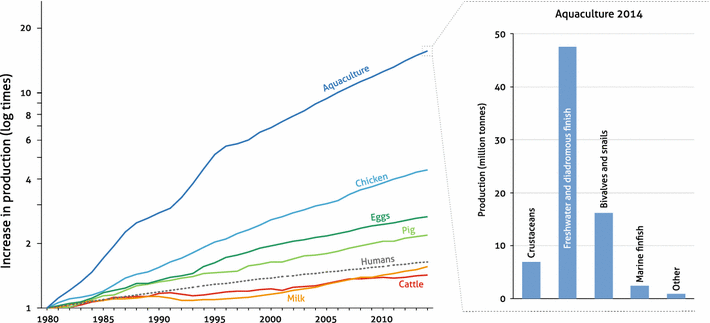This paper may be of interest: Unpacking factors influencing antimicrobial use in global aquaculture.
Henriksson, P.J.G., Rico, A., Troell, M. et al. Sustain Sci (2017). https://doi.org/10.1007/s11625-017-0511-8
Abstract: Global seafood provides almost 20% of all animal protein in diets, and aquaculture is, despite weakening trends, the fastest growing food sector worldwide. Recent increases in production have largely been achieved through intensification of existing farming systems, resulting in higher risks of disease outbreaks. This has led to increased use of antimicrobials (AMs) and consequent antimicrobial resistance (AMR) in many farming sectors, which may compromise the treatment of bacterial infections in the aquaculture species itself and increase the risks of AMR in humans through zoonotic diseases or through the transfer of AMR genes to human bacteria. Multiple stakeholders have, as a result, criticized the aquaculture industry, resulting in consequent regulations in some countries. AM use in aquaculture differs from that in livestock farming due to aquaculture’s greater diversity of species and farming systems, alternative means of AM application, and less consolidated farming practices in many regions. This, together with less research on AM use in aquaculture in general, suggests that large data gaps persist with regards to its overall use, breakdowns by species and system, and how AMs become distributed in, and impact on, the overall social-ecological systems in which they are embedded. This paper identifies the main factors (and challenges) behind application rates, which enables discussion of mitigation pathways. From a set of identified key mechanisms for AM usage, six proximate factors are identified: vulnerability to bacterial disease, AM access, disease diagnostic capacity, AMR, target markets and food safety regulations, and certification. Building upon these can enable local governments to reduce AM use through farmer training, spatial planning, assistance with disease identification, and stricter regulations. National governments and international organizations could, in turn, assist with disease-free juveniles and vaccines, enforce rigid monitoring of the quantity and quality of AMs used by farmers and the AM residues in the farmed species and in the environment, and promote measures to reduce potential human health risks associated with AMR.
Hat tip to Olga Francino for this – I saw her post about it on Twitter:
Reading “Unpacking factors influencing antimicrobial use in global aquaculture and their implication for management: a review from a systems perspective” by Patrik J. G. Henriksson & col https://t.co/ReARQF5cxR pic.twitter.com/rOng3WhehP
— Olga Francino (@olga_francino) November 22, 2017
Note – the use of antimicrobials in aquaculture has potential for some major environmental side effects since many aquaculture systems are more connected to oceans and lakes and other water systems than other locations where antimicrobials are in heavy use. It seems to me that we need some major efforts on studying the side effects (resistance, altering microbial communities) of antimicrobial use in aquaculture.
Some other papers to consider
- Antimicrobial resistance and antimicrobial resistance genes in marine bacteria from salmon aquaculture and non‐aquaculture sites
- Aquaculture as yet another environmental gateway to the development and globalisation of antimicrobial resistance
- Determination of illegal antimicrobials in aquaculture feed and fish: an ELISA study
